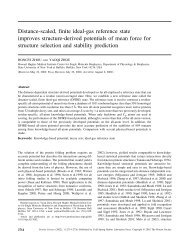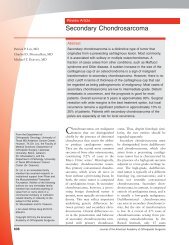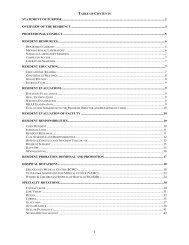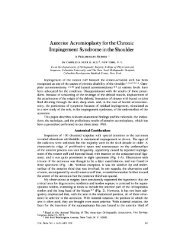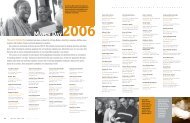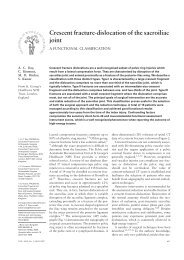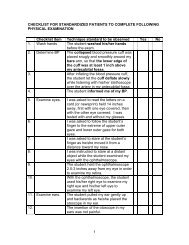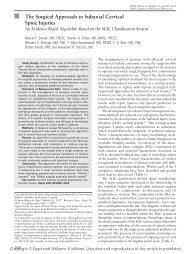Clinical Approach to Acid-base Disorders - University at Buffalo
Clinical Approach to Acid-base Disorders - University at Buffalo
Clinical Approach to Acid-base Disorders - University at Buffalo
Create successful ePaper yourself
Turn your PDF publications into a flip-book with our unique Google optimized e-Paper software.
<strong>Clinical</strong> <strong>Approach</strong> <strong>to</strong> <strong>Acid</strong>-<strong>base</strong><br />
<strong>Disorders</strong><br />
Nasir M. Khan, MD<br />
Department of Medicine<br />
<strong>University</strong> <strong>at</strong> <strong>Buffalo</strong>
Basic Concepts<br />
• Henderson-Hasselbach equ<strong>at</strong>ion:<br />
[H + ]=24x(P CO / [HCO 3 - a 2 3] ) expressed in<br />
nEq/L<br />
• Normal pH=7.36-7.44<br />
•P a CO 2 = 36-44 mm Hg<br />
• [HCO 3 ] - =22-26 26 mEq/L
<strong>Acid</strong>-Base <strong>Disorders</strong><br />
• Metabolic <strong>Disorders</strong> are caused by a disturbance<br />
in [HCO 3 ] - . Metabolic <strong>Acid</strong>osis is present when<br />
[HCO 3 ] - is low and metabolic alkalosis is present<br />
when [HCO 3 ] - is high<br />
• Respira<strong>to</strong>ry disorders d are caused dby changes in the<br />
P a CO 2. When the P a CO 2 is high, respira<strong>to</strong>ry<br />
acidosis is said <strong>to</strong> be present, and when P a CO 2 is<br />
low, respira<strong>to</strong>ry alkalosis is present.
Compensa<strong>to</strong>ry Changes<br />
• These changes tend <strong>to</strong> correct the pH but do not<br />
completely normalize it.<br />
• An alter<strong>at</strong>ion in one component of the P a CO 2 /<br />
[HCO 3 ] - ) r<strong>at</strong>io changes the other component in the<br />
same direction i <strong>to</strong> limit i changes in [H + ]<br />
concentr<strong>at</strong>ion (and thus the pH).<br />
• Ventila<strong>to</strong>ry t response of the lungs <strong>to</strong> alter P a CO 2 is<br />
prompt but the kidney may take many hours <strong>to</strong><br />
compens<strong>at</strong>e.
Maintenance of <strong>Acid</strong>-Base<br />
Balance<br />
• Kidneys alter the r<strong>at</strong>e of absorption of [HCO 3 ] - by<br />
increasing its absorption when P a CO 2 increases<br />
(respira<strong>to</strong>ry acidosis) and decreasing the r<strong>at</strong>e of<br />
absorption of [HCO 3 ] - when P a CO 2 decreases<br />
(respira<strong>to</strong>ry alkalosis)<br />
• Lungs compens<strong>at</strong>e for a change in [HCO 3 ] - by<br />
increasing the ventil<strong>at</strong>ion <strong>to</strong> reduce P a CO 2 in<br />
metabolic acidosis and decreasing the ventil<strong>at</strong>ion<br />
<strong>to</strong> reduce P a aCO 2 in metabolic alkalosis.
Rules of <strong>Acid</strong>-Base Problem<br />
Interpret<strong>at</strong>ion<br />
1. Check for internal consistency<br />
2. Examine the pH<br />
3. Determine if the primary problem is<br />
metabolic or respira<strong>to</strong>ry<br />
4. Calcul<strong>at</strong>e the anion gap<br />
5. Is it a simple or a mixed disturbance?<br />
6. Determine the underlying clinical problem
Rule #1: Check for Internal<br />
Consistency<br />
• The pH and P a CO 2 is measured from an<br />
arterial blood gas (ABG) sample and the<br />
[HCO 3 ] - is then calcul<strong>at</strong>ed using the<br />
Henderson-Hasselbach equ<strong>at</strong>ion.<br />
• Serum measured [HCO 3 ] - should be within<br />
2 mmol/L of the calcul<strong>at</strong>ed [HCO -.<br />
3 ]
Internal Consistency (contd)<br />
• pH can be calcul<strong>at</strong>ed as follows:<br />
– At pH 7.0, [H + ]=100 nmol/L<br />
– At each increment of 0.1 pH unit above 7.0,<br />
multiply pythe previous value by 0.8<br />
– For pH less than 7.0, multiply each 0.1 change<br />
in pH by 1.25
Rule #2: Examine the pH<br />
• A reduction below the normal range<br />
suggests acidosis, while an elev<strong>at</strong>ion is<br />
indic<strong>at</strong>ive of alkalosis
Rule #3: Determine if the<br />
primary problem is metabolic or<br />
respira<strong>to</strong>ry<br />
• A primary metabolic disorder is present if<br />
the [HCO 3 ] - is abnormal. The pH and P a CO 2<br />
change in the same direction.<br />
• A primary respira<strong>to</strong>ry disorder is present if<br />
the P a CO 2 is abnormal. The pH and P a CO 2<br />
change in the opposite direction.
Rule #4:Calcul<strong>at</strong>e the anion gap<br />
• The anion gap (AG) is an estim<strong>at</strong>e of unmeasured<br />
anions and is calcul<strong>at</strong>ed as follows:<br />
AG = Na - (Cl + HCO 3 ).<br />
Normal range is 6-12 mEq/L.<br />
Reduction in plasma proteins, particularly albumin may<br />
decrease the AG by about 1/3.<br />
• AG helps <strong>to</strong> determine if the metabolic acidosis is<br />
due <strong>to</strong> accumul<strong>at</strong>ion of [H + ] e.g. DKA or a loss of<br />
[HCO 3 ] - as in diarrhea.<br />
• Calcul<strong>at</strong>e ΔAG/ Δ [HCO - 3 ] r<strong>at</strong>io or add ΔAG <strong>to</strong><br />
[HCO 3 ] - <strong>to</strong> obtain ‘corrected’ [HCO 3 ] -
Rule #5: Is it a simple or a mixed<br />
disturbance?<br />
• A simple acid-<strong>base</strong> disorder is present if an<br />
expected compensa<strong>to</strong>ry response is seen.<br />
• A mixed d( (acidosis i and alkalosis) l )disorder d is<br />
present if the P a CO 2 or AG is abnormal and the pH<br />
is normal or unchanged, or if the pH is abnormal<br />
and the P a CO 2 is normal or unchanged. These can<br />
be.<br />
– Mixed metabolic and respira<strong>to</strong>ry disorders.<br />
– Mixed metabolic disorders.<br />
– Complex mixed disorders.
Mixed Disturbance<br />
• <strong>Acid</strong>osis<br />
• Alkalosis<br />
• Normal pH
Mixed Disturbance<br />
• <strong>Acid</strong>osis.<br />
– If the pH is low or AG is high , and the P a CO 2 is low or<br />
normal, a primary metabolic acidosis is present. The<br />
difference between the measured and the expected<br />
P a CO 2 is then used <strong>to</strong> identify a superimposed<br />
respira<strong>to</strong>ry disorder.<br />
d<br />
– If the pH is low and the P a CO 2 is high, a primary<br />
respira<strong>to</strong>ry acidosis is present. The difference between<br />
the measured and the expected [HCO 3 ] - is then used <strong>to</strong><br />
identify a superimposed metabolic disorder. A low<br />
[HCO 3 ] - may also indic<strong>at</strong>e a metabolic disorder with<br />
superimposed respira<strong>to</strong>ry acidosis.
Mixed Disturbance (contd)<br />
• Alkalosis.<br />
– If the pH is high, a normal or high P a CO 2 indic<strong>at</strong>es a<br />
primary metabolic alkalosis. The difference between<br />
the measured and the expected P a CO 2 is then used <strong>to</strong><br />
identify a superimposed respira<strong>to</strong>ry disorder.<br />
– If the pH is high, a low P a CO 2 indic<strong>at</strong>es a primary<br />
respira<strong>to</strong>ry alkalosis. The difference between the<br />
measured and the expected d[HCO 3 ] - is then used <strong>to</strong><br />
identify a superimposed metabolic disorder.
Mixed Disturbance (contd)<br />
• Normal pH.<br />
– Low P a CO 2 indic<strong>at</strong>es mixed respira<strong>to</strong>ry<br />
alkalosis-metabolic acidosis.<br />
– High P aCO 2 indic<strong>at</strong>es mixed respira<strong>to</strong>ry<br />
acidosis-metabolic alkalosis.<br />
– Normal P aCO 2 indic<strong>at</strong>es metabolic acidosis co-<br />
existing with metabolic alkalosis. Anion gap<br />
will be elev<strong>at</strong>ed.
Expected Compensa<strong>to</strong>ry<br />
Responses<br />
• Metabolic <strong>Acid</strong>osis: P a CO 2 =1.5 [HCO 3 ] - +8±2<br />
• Metabolic alkalosis:ΔP aCO 2 =0.7× Δ[HCO[ 3 3]<br />
-<br />
• Respira<strong>to</strong>ry <strong>Acid</strong>osis:<br />
– Acute: ↑[HCO - 3 ] = 1mEq/L×Δ Δ P a CO 2 /10<br />
– Chronic: ↑[HCO 3 ] - = 3.5 mEq/L ×Δ P a CO 2 /10<br />
• Respira<strong>to</strong>ry alkalosis:<br />
– Acute: ↓[HCO 3 ] - = 2 mEq/L ×Δ P a CO 2 /10<br />
– Chronic: c:↓[ ↓[HCO - 3 ] = 4 mEq/L ×Δ P a aCO 2 /10
Metabolic <strong>Acid</strong>osis<br />
1. Hyperchloremic or normal AG acidosis<br />
• Renal causes e.g. RTA, renal insufficiency<br />
• Urine AG is positive<br />
• Urine AG= Na+K-Cl (spot urine electrolytes)<br />
• Non-renal causes e.g. diarrhea<br />
• Urine AG is neg<strong>at</strong>ive
Metabolic <strong>Acid</strong>osis<br />
2. High AG acidosis:<br />
1. Lactic acidosis,<br />
2. Ke<strong>to</strong>acidosis,<br />
3. Ingested <strong>to</strong>xins,<br />
• Aspirin<br />
• Ethanol, methanol, ethylene glycol (osmolal<br />
gap)<br />
4. Acute or chronic renal failure
“MUD PILES”<br />
• M-Methanol<br />
• U-Uremia<br />
• D-Diabetic Ke<strong>to</strong>acidosis<br />
• P-Paraldehyde<br />
• I-Infection, Iron, Isoniazid<br />
• L-Lactic Lactic acidosis<br />
• E-Ethylene Glycol, Ethanol<br />
• S-Salicyl<strong>at</strong>es
Metabolic Alkalosis<br />
1. Chloride sensitive: urine Cl < 15 mEq/L.<br />
Causes include volume depletion, gastric<br />
drainage, diuretics, villous adenoma etc.<br />
2. Chloride resistant: urine Cl > 25 mEq/L.<br />
Causes include mineralocorticoid excess,<br />
Bartter’s syndrome, Cushing’s s syndrome etc.
Respira<strong>to</strong>ry <strong>Acid</strong>osis<br />
Primary problem is inadequ<strong>at</strong>e ventil<strong>at</strong>ion.<br />
1. Acute: acute airway obstruction, drugs,<br />
cardiopulmonary arrest, acute severe lung<br />
disease.<br />
2. Chronic: COPD, neuromuscular diseases,<br />
restrictive lung diseases.
Respira<strong>to</strong>ry Alkalosis<br />
1.Problem caused by voluntary or mechanical<br />
hyperventil<strong>at</strong>ion or increased neurochemical<br />
stimul<strong>at</strong>ion of ventil<strong>at</strong>ion by central or<br />
peripheral p causes e.g. anxiety, head trauma,<br />
CNS tumors/infections, drugs, pain, fever,<br />
pulmonary embolism, pneumonia, CHF,<br />
asthma etc.




